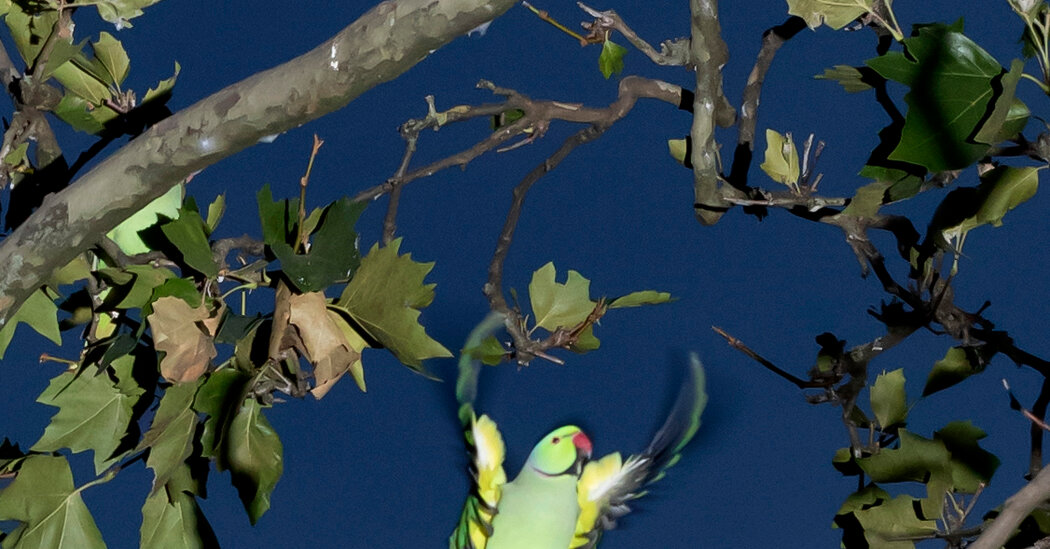In the vibrant Flagey neighborhood of Brussels, two things are certain: People will be waiting in line for fries at Frit Flagey, and pigeons will be nearby picking at crumbs.
Just a few hundred yards away, at dusk, a scene unfolds that feels far from typical Belgian.
Hundreds of electric green parakeets, more commonly found in the tropical climates of West Africa or India than in the gray, rainy city of Brussels, flock to a tree by a pond. They sleep there for the night, turning the tree a brighter shade of green, and take flight at dawn.
The population of rose-ringed parakeets in Brussels has increased from just a few in the 1970s to around 10,000 today, making it one of the most common bird species in the city, after pigeons and sparrows. As the population of wild parakeets has grown not only in Brussels but also in London, Paris, and over 100 other European cities, researchers are trying to understand how a tropical species has thrived in cold climates.
One explanation for the thousands of parakeets in Brussels today is that they descend from a small group of birds that were released in the 1970s from a zoo and theme park, Meli Park Heysel, in the city.
According to local lore, the zoo’s director, Guy Florizoone, released the birds to add a splash of color to the city. “The start of the Brussels populations was without doubt the release of several tens of birds from the zoo,” said Diederik Strubbe, an environmental scientist at Ghent University in Belgium who studied parakeet populations for his Ph.D. thesis.
When reached by phone, Mr. Florizoone, now 80, said he had released 40 to 50 parakeets in the early 1970s as part of an experiment called “Birds in Freedom,” so that visitors could see them roam freely. Most of the parakeets returned, he said, but a few did not.
However, he said his experiment “has little connection” to the enormous population growth of parakeets in Belgium and across Europe, including Britain. “It’s impossible that such numbers would have flown over the Channel,” he said. “They’re not capable of that.”
(Mr. Florizoone’s wife, Marie-Claire, is less convinced about her husband’s role in the spread of parakeets in Brussels: “The only thing I know is that my husband is not responsible,” she said, “although people keep on thinking that.”)
Mr. Florizoone said that warmer weather in Europe has accelerated the population growth of parakeets, a link confirmed by the ParrotNet project at the University of Kent in England, which studies how parakeets affect ecosystems.
In addition to milder winters, parakeets benefit from a lack of predators and abundant food supplies in cities like Brussels, according to ornithologists.
“Urban areas are like an all-you-can-eat restaurant,” said Dr. Strubbe.
Parakeets have been damaging to crops and other animals, including bats.
Jimmy Foucault, a journalist walking by the tree full of parakeets on a Sunday evening in September, expressed concern about the abundance of tropical birds in Brussels. “These kinds of species in Belgium – it’s just weird,” he said.
But in Brussels, they have coexisted harmoniously with other species thanks to the city’s preservation of old trees that are ideal for cavity-nesting birds like parakeets, said Jean-Yves Paquet, a director at Natagora, an organization focused on environmental preservation in Brussels. (In London, the ancient parklands of Hyde Park and Richmond Park are also popular places for parakeets).
“There is enough space for everybody, in fact,” said Mr. Paquet.
The authorities have asked the public not to feed the birds, but are not actively trying to limit their population growth, he said. Having “really cool-looking wildlife” can bring positive mental health benefits, said Jim Groombridge, the ParrotNet chair and a professor of biodiversity at the University of Kent.
While some people welcome the parakeets, others see them as noisy pests. When they took up residence outside the former NATO headquarters in Brussels, the birds were so disruptive that officials attempted to encourage them to relocate by playing recordings of falcons and hawks from loudspeakers mounted among the trees.
Still, Matthew Klimow, the former deputy assistant secretary general of NATO, fondly remembered the birds. “The parakeets were part of the charm of urban living in a city adorned by acres of big leafy trees,” he wrote in an email from Turkmenistan, where he is now the U.S. ambassador.
On an evening in September, Brigitte Dufour, a human rights lawyer, paused to admire the parakeets as they gathered at dusk, chirping loudly. “For me, they just bring joy,” said Ms. Dufour, while walking with her dog, Roméo. She loves waking up to the sounds of parakeets each morning, giving her the feel of being surrounded by nature, rather than in a big city. “I think that if they can live alongside with other species here, why not?”
Claire Moses contributed reporting.
